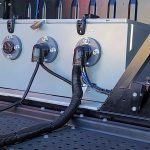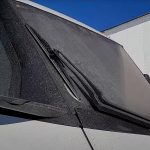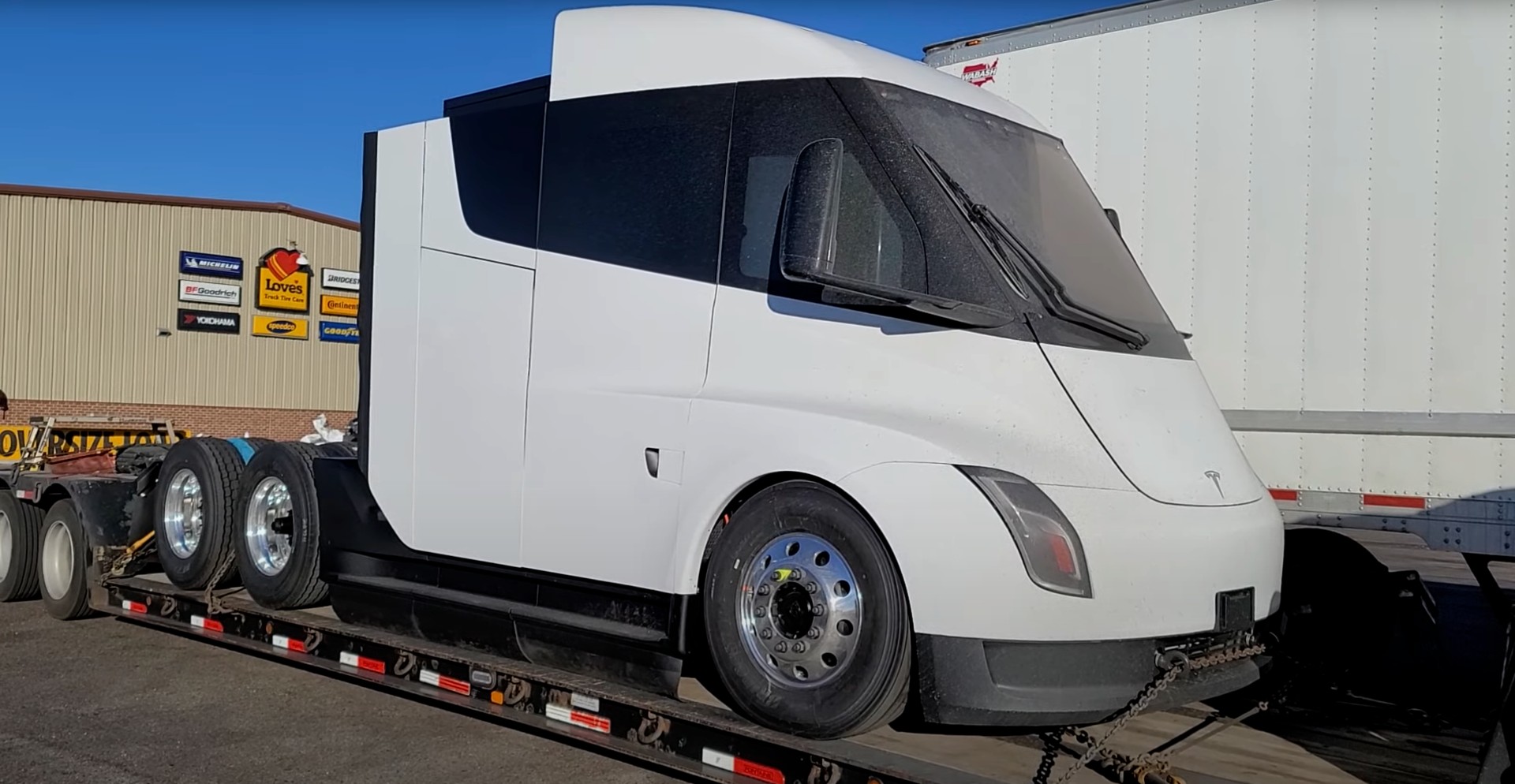
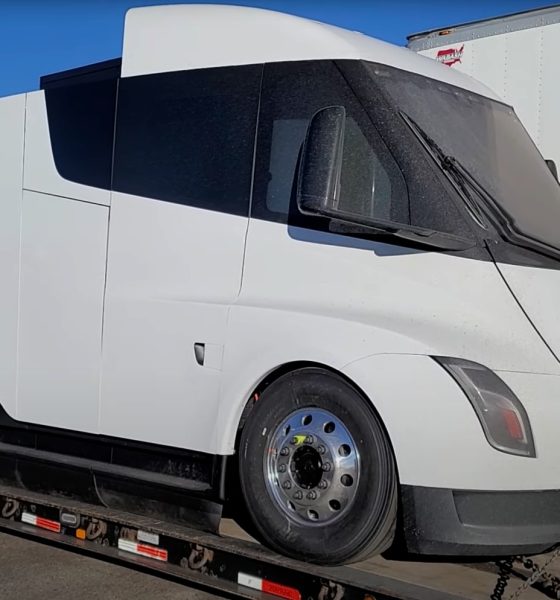
News
Tesla Semi production rumors swirl as frequent sightings up the ante on expectations
Rumors surrounding the Tesla Semi are plentiful in this day and age, especially as sightings of the company’s commercial vehicle are becoming more frequent. Expectations for the new Semi are high already, and Tesla aims to deliver the truck in a timely fashion after several delays.
The new Semi has been spotted numerous times over the past week, hinting toward ongoing testing before Tesla starts volume production of the massive, all-electric commercial vehicle. Less than two weeks after Tesla’s Q4 2020 Earnings Call, where CEO Elon Musk and others detailed the ongoing offensive to develop the vehicle, the Semi is being spotted by people on public roads. Although Musk stated battery constraint is the hold-up in the Semi’s production, it isn’t stopping the company from testing several new truck builds.
Speculation regarding when Tesla will finally begin volume production is growing, and more rumors surrounding the initial deliveries to pre-orderers appear on what seems like a daily basis. However, the big bottleneck is batteries, and Tesla plans to combat this issue with wide-scale cell production and purchasing. The real question is, how many cells will be “enough?”
EXCLUSIVE: For a few weeks I’ve been in contact with a source from a U.S Tesla supplier. They supply certain parts for the S,X,3 and Y, but I’m here to reveal some info on Tesla Semi. As always, take these kinds of things with a grain of salt. Things/timelines can change.
1/6
— Sawyer Merritt ?? (@SawyerMerritt) February 4, 2021
Elon Musk’s Earnings Call Comments
Musk, who stated last year that it was time for Tesla to enter volume production of the Semi, had a different tune during the Q4 2020 Earnings Call on January 27th. Battery cell constraint is a major bottleneck in starting the Semi production, as fulfilling the number of orders it has would likely inhibit Tesla from being able to produce its mass-market passenger vehicles, like the Model 3 and Model Y.
Tesla has recently started producing its own battery cells at a plant that sits adjacent to its main production facility in Fremont, California. Known as the “Kato Road Facility,” Tesla is building its new 4680 cells there, a battery that Tesla claims will cut the cost of its vehicles massively, putting it on a crash course to reach price parity with gas-powered vehicles. The Semi will require significantly more cells than any other Tesla vehicle to date, a problem that the company is aiming to solve by producing its own cells and buying additional ones from third-party suppliers like Panasonic.
Tesla’s 4680 Kato Rd. facility has a top 10 capacity, and it’s not even close to finished
During the Earnings Call, Musk said:
“Prototypes are easy. Scaling production is very hard. So a big part of the reason — the main reason we have not accelerated new products is — like, for example, Tesla Semi is that we simply don’t happen our cells group. We — this — if we were to make the Semi like right now, which we could easily go into production with the Semi, but we would not have enough to cells built for it right now. We will have cells group in ourselves for Semi when we are producing the 4680 volume. But for example, Semi would use typically five times the number of cells that a car would use, but it would not sell for five times what a car would sell for. So it kind of doesn’t make — it would not make sense for us to do the Semi right now, but it will absolutely make sense for us to do it as soon as we can address the cell production constraint. The same would go for that.”
Effectively, Musk explained that it makes more fiscal sense to focus on the mass-market consumer products for right now. When the Kato Rd. Facility begins a massive production of the 4680 cells, Tesla can begin the Semi production efforts, but that doesn’t mean prototypes aren’t on the road now.
New Sightings
Following a sighting by The Kilowatts last week, two new sightings of the Semi have surfaced of the all-white Tesla commercial vehicle.
New Tesla Semi with updated windows, door handles, and tail lights spotted in Sacramento
One video from Cory Draper on YouTube shows a four-and-a-half-minute-long walk around of the Semi, getting a close-up look at the vehicle. One of the most striking features is the size of the power cell, as Draper estimates it is between four and five feet in length. A massive truck requires a massive power source, and the Semi’s sizeable battery storage compartment will drive the truck’s 300 or 500-mile range. Another video from Ivaylo Tzintzarsky shows the power cell from the opposite side.
- YouTube: Cory Draper
- YouTube: Ivaylo Tzintzarsky
There are also numerous sensors that can be seen on the Semi, especially in Draper’s video. The top of the windshield is outfitted with at least five sensors that will help with the autonomous driving functionality of the Tesla Semi. Autonomy could help with the evolution of the trucking industry, as many drivers are currently restricted to 11 hours of travel per day, according to the Federal Motor Carrier Safety Administration (FMCSA).
Fuel savings alone could pay for a Tesla Semi, as the company estimates it will save at least $200,000. Combined with superior aerodynamic performance and, a quad-motor powertrain, and a low center of gravity to prevent rollovers, the Tesla Semi has the potential to revolutionize the trucking industry forever. The question is: When will it begin production, and how long until Tesla can produce the 4680 cells in mass quantities to solve the constraint issue?
Watch the two newest sightings of the Semi below. Let us know what you think in the comments!

Elon Musk
Tesla CEO Elon Musk confirms Robotaxi safety monitor removal in Austin: here’s when
Musk has made the claim about removing Safety Monitors from Tesla Robotaxi vehicles in Austin three times this year, once in September, once in October, and once in November.

Tesla CEO Elon Musk confirmed on Tuesday at the xAI Hackathon that the company would be removing Safety Monitors from Robotaxis in Austin in just three weeks.
This would meet Musk’s timeline from earlier this year, as he has said on several occasions that Tesla Robotaxis would have no supervision in Austin by the end of 2025.
On Tuesday, Musk said:
“Unsupervised is pretty much solved at this point. So there will be Tesla Robotaxis operating in Austin with no one in them. Not even anyone in the passenger seat in about three weeks.”
Musk has made the claim about removing Safety Monitors from Tesla Robotaxi vehicles in Austin three times this year, once in September, once in October, and once in November.
In September, he said:
“Should be no safety driver by end of year.”
The safety driver is just there for the first few months to be extra safe.
Should be no safety driver by end of year.
— Elon Musk (@elonmusk) September 4, 2025
On the Q3 Earnings Call in October, he said:
“We are expecting ot have no safety drivers in at least large parts of Austin by the end of this year.”
Finally, in November, he reiterated the timeline in a public statement at the Shareholder Meeting:
“I expect Robotaxis to operate without safety drivers in large parts of Austin this year.”
Currently, Tesla uses Safety Monitors in Austin in the passenger’s seat on local roads. They will sit in the driver’s seat for highway routes. In the Bay Area ride-hailing operation, there is always a Safety Monitor in the driver’s seat.
Three weeks would deliver on the end-of-year promise, cutting it close, beating it by just two days. However, it would be a tremendous leap forward in the Robotaxi program, and would shut the mouths of many skeptics who state the current iteration is no different than having an Uber.
Tesla has also expanded its Robotaxi fleet this year, but the company has not given exact figures. Once it expands its fleet, even more progress will be made in Tesla’s self-driving efforts.
News
SpaceX reportedly mulling IPO, eyeing largest of all time: report
“I do want to try to figure out some way for Tesla shareholders to participate in SpaceX. I’ve been giving a lot of thought to how to give people access to SpaceX stock,” Musk said.
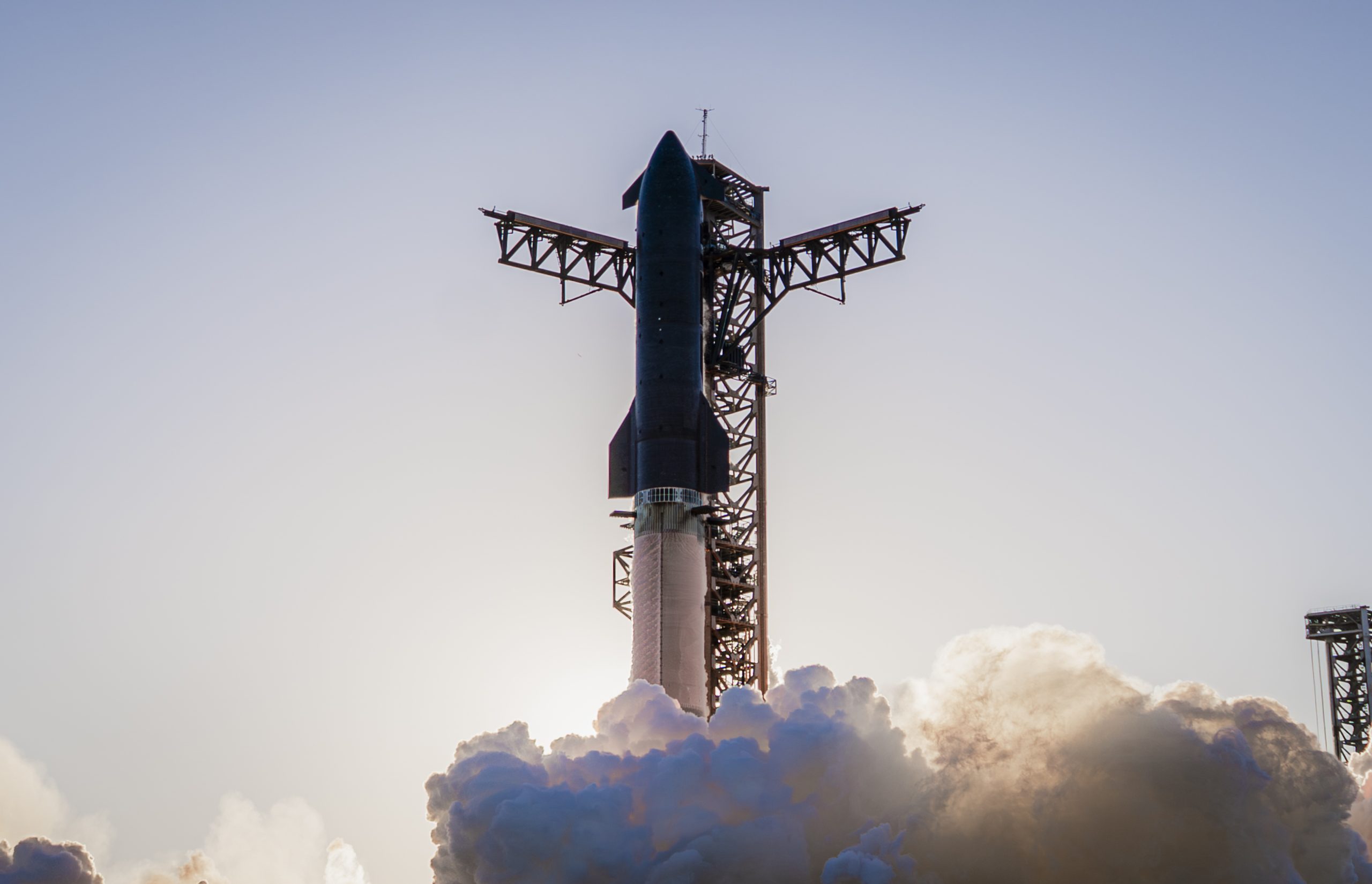
SpaceX is reportedly mulling an initial public offering, eyeing what would be the largest valuation at the time of availability of all time, a new report from Bloomberg said on Tuesday.
It is one of many reports involving one of Elon Musk’s companies and a massive market move, as this is not the first time we have seen reports of an IPO by SpaceX. Musk himself has also dispelled other reports in the past of a similar nature, including an xAI funding round.
SpaceX and Musk have yet to comment on the report. In the past, untrue reports were promptly replied to by the CEO; this has not yet gained any response, which is a good sign in terms of credibility.
However, he said just a few days ago that stories of this nature are inaccurate:
“There has been a lot of press claiming SpaceX is raising money at $800B, which is not accurate. SpaceX has been cash flow positive for many years and does periodic stock buybacks twice a year to provide liquidity for employees and investors. Valuation increments are a function of progress with Starship and Starlink and securing global direct-to-cell spectrum that greatly increases our addressable market. And one other thing that is arguably most significant by far.”
There has been a lot of press claiming @SpaceX is raising money at $800B, which is not accurate.
SpaceX has been cash flow positive for many years and does periodic stock buybacks twice a year to provide liquidity for employees and investors.
Valuation increments are a…
— Elon Musk (@elonmusk) December 6, 2025
Musk has discussed a potential IPO for SpaceX in recent months, as the November 6 shareholder meeting, as he commented on the “downsides” of having a public company, like litigation exposure, quarterly reporting pressures, and other inconveniences.
Nevertheless, Musk has also said he wants there to be a way for Tesla shareholders to get in on the action. At the meeting in early November, he said:
“I do want to try to figure out some way for Tesla shareholders to participate in SpaceX. I’ve been giving a lot of thought to how to give people access to SpaceX stock.”
Additionally, he added:
“Maybe at some point., SpaceX should become a public company despite all the downsides of being public.”
Musk has been historically reluctant to take SpaceX public, at times stating it could become a barrier to colonizing Mars. That does not mean it will not happen.
Bloomberg’s report cites multiple unidentified sources who are familiar with the matter. They indicate to the publication that SpaceX wants to go public in mid-to-late 2026, and it wants to raise $30 billion at a valuation of around $1.5 trillion.
This is not the first time SpaceX has discussed an IPO; we reported on it nine years ago. We hope it is true, as the community has spoken for a long time about having access to SpaceX stock. Legendary investor Ron Baron is one of the lucky few to be a SpaceX investor, and said it, along with Tesla, is a “lifetime investment.”
Tesla bull Ron Baron reveals $100M SpaceX investment, sees 3-5x return on TSLA
The primary driver of SpaceX’s value is Starlink, the company’s satellite internet service. Starlink contributes 60-70 percent of SpaceX’s revenue, meaning it is the primary value engine. Launch services, like Falcon 9 contracts, and the development of Starship, also play supporting roles.
News
SpaceX reaches incredible milestone with Starlink program

SpaceX reached an incredible milestone with its Starlink program with a launch last night, as the 3,000th satellite of the year was launched into low Earth orbit.
On Monday, SpaceX also achieved its 32nd flight with a single Falcon 9 rocket from NASA’s Kennedy Space Center.
The mission was Starlink 6-92, and it utilized the Falcon 9 B1067 for the 32nd time this year, the most-used Falcon booster. The flight delivered SpaceX’s 3000th Starlink satellite of the year, a massive achievement.
There were 29 Starlink satellites launched and deployed into LEO during this particular mission:
Falcon 9 launches 29 @Starlink satellites from Florida pic.twitter.com/utKrXjHzPN
— SpaceX (@SpaceX) December 9, 2025
SpaceX has a current goal of certifying its Falcon boosters for 40 missions apiece, according to Spaceflight Now.
The flight was the 350th orbital launch from the nearby SLC-40, and the 3,000 satellites that have been successfully launched this year continue to contribute to the company’s goal of having 12,000 satellites contributing to global internet coverage.
There are over five million users of Starlink, the latest data shows.
Following the launch and stage separation, the Falcon 9 booster completed its mission with a perfect landing on the ‘Just Read the Instructions’ droneship.
The mission was the 575th overall Falcon 9 launch, highlighting SpaceX’s operational tempo, which continues to be accelerated. The company averages two missions per week, and underscores CEO Elon Musk’s vision of a multi-planetary future, where reliable connectivity is crucial for remote work, education, and emergency response.
As Starlink expands and works toward that elusive and crucial 12,000 satellite goal, missions like 6-92 pave the way for innovations in telecommunications and enable more internet access to people across the globe.
With regulatory approvals in over 100 countries and millions of current subscribers, SpaceX continues to democratize space, proving that reusability is not just feasible, but it’s also revolutionary.
